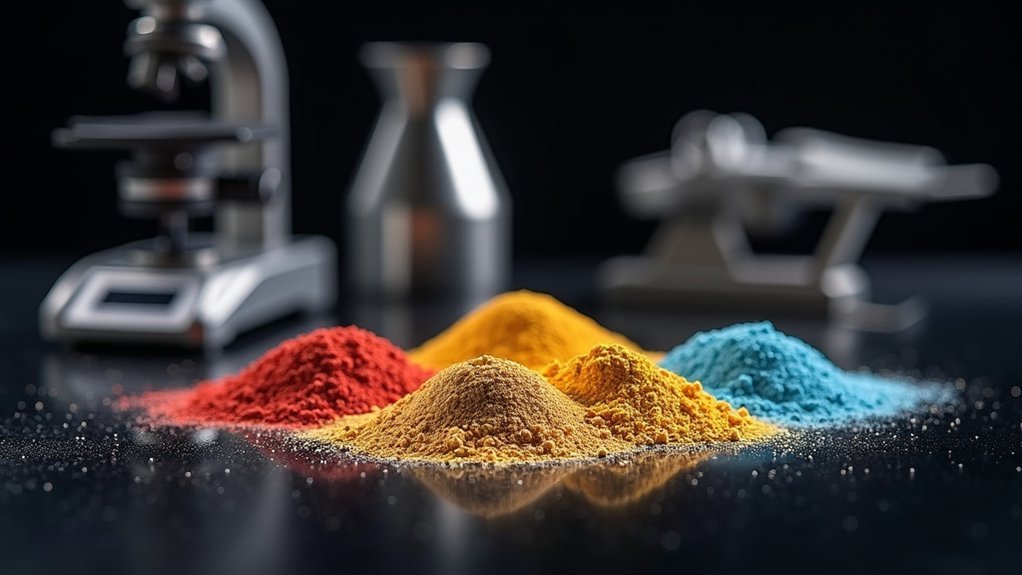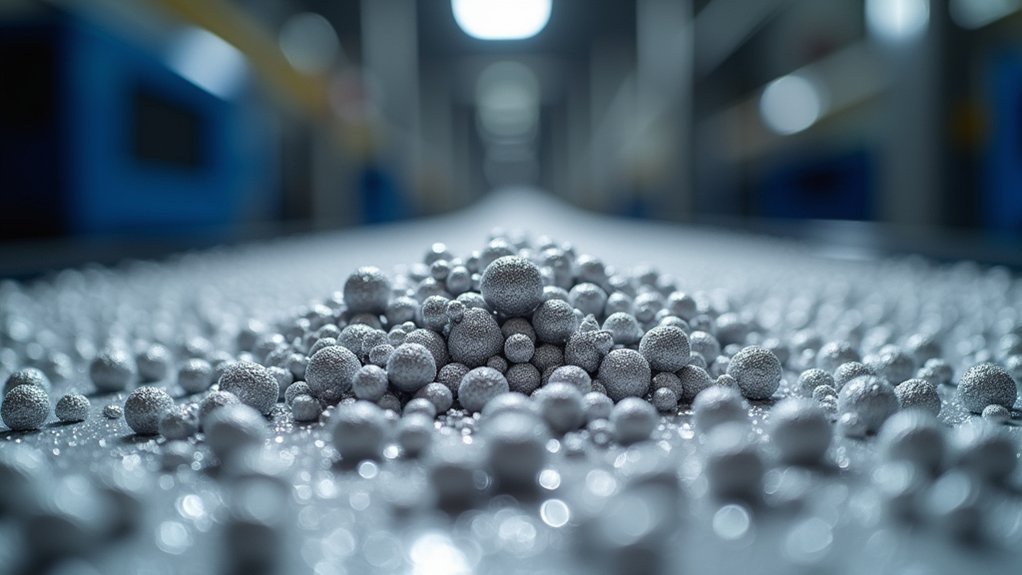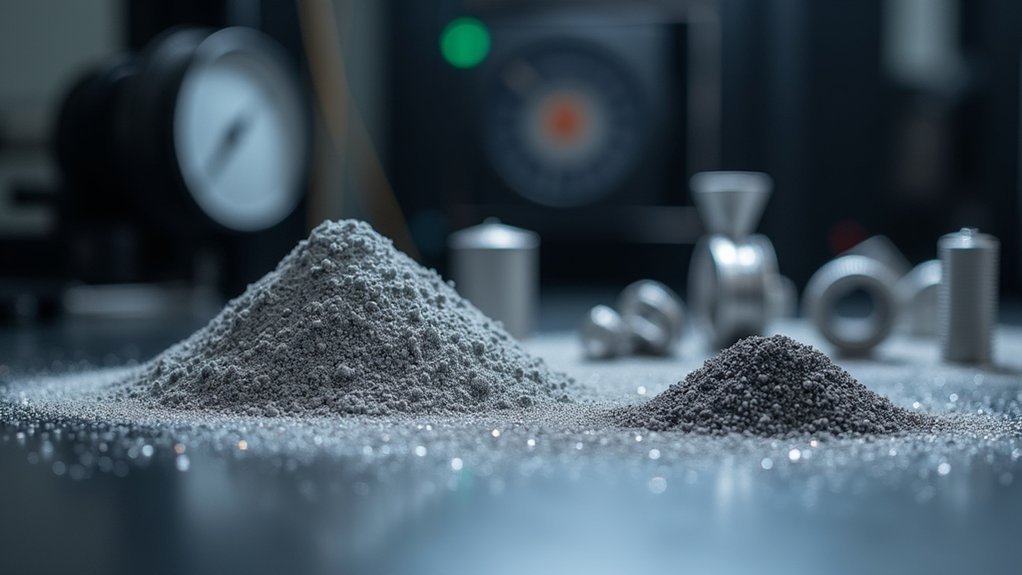When selecting Inconel powder for aerospace 3D printing, you’ll need to prioritize particle size between 15-45 microns for ideal resolution and flowability. Choose Inconel 718 with 50-55% nickel content that meets AMS 5383 specifications. Verify your supplier holds AS9100 certification and uses gas or plasma atomization for spherical particles. Make sure oxygen levels stay under 0.1% and confirm the powder achieves an angle of repose ≤30°. Understanding these specifications will help you navigate the complete selection process.
Understanding Inconel Alloy Types for Aerospace Applications

When you’re selecting Inconel powder for aerospace 3D printing, understanding the distinct characteristics of each alloy type becomes essential for mission-critical applications.
Inconel 718 stands as your primary choice, offering exceptional high-temperature strength and corrosion resistance up to 704°C. Its composition features 50-55% nickel, 17-21% chromium, plus niobium and molybdenum for superior mechanical properties.
Inconel 718 delivers exceptional high-temperature performance up to 704°C with superior nickel-chromium composition for demanding aerospace applications.
For higher temperature demands reaching 980°C, you’ll want Inconel 625, which delivers outstanding oxidation resistance.
Inconel 600 serves specialized aerospace applications requiring excellent resistance to oxidation and carburization in extreme environments.
These Inconel alloys prove indispensable for turbine blades, heat exchangers, and combustion chambers where conventional materials fail under harsh conditions.
Particle Size Requirements for Optimal Print Quality
You’ll need to carefully consider particle size when selecting Inconel powder, as it directly affects your print quality and component performance.
The size range you choose impacts three critical factors: ideal density ranges that guarantee structural integrity, layer resolution that determines surface finish and detail accuracy, and flowability characteristics that affect powder distribution during printing.
Getting these parameters right means the difference between aerospace-grade components and costly reprints.
Optimal Size Ranges
Although particle size might seem like a minor detail, it’s actually one of the most critical factors determining your print quality when working with Inconel 718 powder.
The ideal particle size range for aerospace applications falls between 15-45 microns, striking the perfect balance between flowability and packing density that your 3D printing process demands.
When you’re targeting superior resolution and surface finish, you’ll want to focus on the finer end of this spectrum—particularly the 15-30 micron range.
However, be prepared for potential dust handling challenges with these smaller particles.
Conversely, if you use particles larger than 45 microns, you’ll compromise the detail and precision your aerospace components require.
Layer Resolution Impact
Because layer resolution directly correlates with your particle size selection, understanding this relationship becomes crucial for achieving the precision aerospace components demand. Your choice impacts print resolution considerably, with smaller particles enabling finer detail reproduction but creating handling challenges.
Consider these critical factors when optimizing layer resolution:
- 30-micron particles provide the ideal balance between detail capture and manageable processing for intricate aerospace geometries.
- Consistent particle size distribution prevents layer inconsistencies that compromise mechanical properties and structural integrity.
- Particles above 45 microns sacrifice resolution quality for faster deposition rates, making them unsuitable for precision aerospace applications.
You’ll find that maintaining tight particle size distribution control directly translates to superior surface finishes and dimensional accuracy.
This consistency guarantees your printed components meet the stringent mechanical properties requirements that aerospace applications demand.
Flowability and Density
Flowability determines your powder’s ability to move smoothly through the printing system, directly affecting layer uniformity and final component quality.
You’ll need to achieve an angle of repose of ≤ 30° for peak powder flow during aerospace 3D printing operations. Your Inconel 718 powder should have an apparent density between 4-5 g/cm³ and tap density ranging from 7-8 g/cm³ to guarantee proper packing characteristics.
Poor flowability creates inconsistent layer deposition, leading to defects in critical aerospace components.
You can maintain excellent flowability through proper handling and sieving techniques, enabling powder reuse 5-10 times without compromising density or flow properties.
Monitor your powder’s flowability regularly, as degraded flow characteristics will compromise print quality and dimensional accuracy in aerospace applications.
Chemical Composition Standards and Specifications
You’ll need to verify that your Inconel 718 powder meets AMS 5383 specifications, which define the exact chemical and mechanical properties required for aerospace applications.
The composition must contain 50-55% nickel, 17-21% chromium, and specific percentages of niobium, molybdenum, titanium, and aluminum, with carbon content capped at 0.08%.
Your supplier should hold ISO 9001 and AS9100 certifications to guarantee the powder meets these stringent quality standards and maintains contamination levels below 0.1% for oxygen and nitrogen.
AMS Specification Requirements
When selecting Inconel powder for aerospace 3D printing, you must confirm strict adherence to AMS (Aerospace Material Specifications) requirements that govern chemical composition standards.
These AMS specification requirements confirm your powder meets aerospace-grade performance criteria for high-stress applications.
You’ll need to focus on three critical AMS standards:
- AMS 5662 – Specifies Inconel 718 composition with 50-55% nickel, 17-21% chromium, and 4.75-5.5% niobium content
- AMS 5596 – Outlines nickel-chromium alloy specifications emphasizing superior corrosion resistance and high strength
- Carbon Content Limits – Restricts maximum carbon to 0.08% preventing brittleness in critical components
You must verify chemical composition through certified testing to confirm compliance.
This verification process confirms your Inconel powder delivers reliable performance in extreme aerospace environments where failure isn’t an option.
Element Content Limits
Beyond AMS compliance verification, precise element content limits define the foundational chemistry that makes Inconel 718 powder suitable for aerospace 3D printing applications.
You’ll need to verify that nickel content falls between 50-55% and chromium ranges from 17-21% for ideal high-temperature performance. Niobium must stay within 4.75-5.5% to enable proper precipitation hardening, while carbon content can’t exceed 0.08% to prevent harmful carbide formation.
| Element | Content Range |
|---|---|
| Molybdenum | 2.8% – 3.3% |
| Titanium | 0.65% – 1.15% |
| Carbon | ≤ 0.08% |
These element content limits for Inconel 718 directly impact your printed components’ corrosion resistance and mechanical strength. Molybdenum and titanium specifications enhance both properties, ensuring your aerospace parts withstand demanding operational environments.
Quality Certification Standards
Since aerospace applications demand uncompromising material performance, quality certification standards establish the critical framework for validating Inconel 718 powder’s chemical composition.
You’ll need suppliers who maintain ISO 9001 and AS9100 certifications, guaranteeing their manufacturing processes meet aerospace industry’s rigorous quality management requirements.
When selecting certified Inconel 718 powder, verify these essential compliance areas:
- Chemical composition verification – Confirm adherence to AMS 5662 standards with proper Nickel (50-55%), Chromium (17-21%), and Niobium (4.75-5.5%) percentages.
- Contamination control – Verify maximum carbon content stays below 0.08% and oxygen/nitrogen levels remain under 0.1%.
- Physical properties testing – Validate particle size distribution, flowability, and density specifications for peak additive manufacturing performance.
Regular batch certification and testing guarantee consistent quality throughout your aerospace 3D printing operations.
Powder Production Methods and Their Impact on Performance
Although multiple techniques exist for producing Inconel powder, the manufacturing method you choose will directly determine your 3D printing success in aerospace applications.
Gas atomized powders deliver spherical particles that enhance flowability and packing density, making them ideal for consistent layer formation.
Water atomization creates irregular shapes with wider size distributions (5-150 μm), compromising print quality and precision.
Plasma atomized powders offer superior spherical particles with narrow distributions (15-45 μm), promoting better melting efficiency and surface finish.
The Rotating Electrode Process produces truncated spheroidal particles that improve surface quality and mechanical properties for critical components.
Each powder production method affects oxygen and nitrogen content differently, with gas atomization maintaining lower contamination levels essential for high-stress aerospace environments.
Quality Certifications and Aerospace Industry Standards

Quality certifications serve as your first line of defense when selecting Inconel powder suppliers for aerospace 3D printing applications.
You’ll need to verify that suppliers hold essential credentials that demonstrate their commitment to aerospace-grade manufacturing standards.
When evaluating potential suppliers, prioritize these critical requirements:
- ISO 9001 and AS9100 certifications – These validate adherence to quality management standards specific to aerospace manufacturing.
- Aerospace material standards compliance – Confirm powder conforms to specifications like AMS 5662 for Inconel 718, covering chemical composition and mechanical properties.
- Comprehensive material test reports – Request documentation detailing particle size distribution, morphology, flowability, and contamination levels with oxygen content capped at 0.1% maximum.
You should also verify the supplier’s batch traceability capabilities, guaranteeing full compliance with aerospace regulations throughout your manufacturing process.
Powder Flowability and Handling Characteristics
Beyond certifications and supplier credentials, the physical properties of Inconel powder directly impact your printing success.
You’ll need powder flowability with an angle of repose ≤ 30° for consistent layer deposition. The ideal particle size range of 15-45 microns guarantees excellent flow characteristics and mechanical interlocking during printing.
Pay attention to apparent density (4-5 g/cm³) and tap density (7-8 g/cm³) as these affect packing efficiency and volume utilization.
Monitor apparent density (4-5 g/cm³) and tap density (7-8 g/cm³) to optimize packing efficiency and maximize volume utilization in your prints.
Implement proper handling techniques by minimizing air exposure and using inert gas environments to prevent oxidation. Store powder correctly to maintain quality throughout the printing process.
You can reuse Inconel 718 powder 5-10 times with proper sieving and handling, making it cost-effective while preserving consistent flow properties for multiple aerospace applications.
Post-Processing Requirements for Aerospace Components

- Hot Isostatic Pressing (HIP) – Closes internal pores and enhances mechanical properties essential for aerospace performance.
- Heat treatment – Optimizes microstructure through aging processes to achieve required strength levels.
- Surface finishing – Machining and polishing guarantee dimensional tolerances and surface quality meet stringent aerospace standards.
You must carefully monitor temperature and time parameters during these processes to maintain material integrity.
Additionally, proper handling and storage of your Inconel powder prevents oxidation and contamination that could compromise component quality throughout the post-processing sequence.
Supplier Evaluation and Selection Criteria
When evaluating potential suppliers for Inconel powder, you’ll need to prioritize those with proven aerospace experience and deep understanding of superalloy requirements.
Your supplier evaluation should focus on verifying that their Inconel 718 powder meets critical specifications, including 15-45 micron particle size and ISO 9001/AS9100 certifications for quality assurance.
Examine their production methods carefully, favoring suppliers using gas atomization or plasma atomization techniques for ideal particle morphology and flowability.
You’ll want suppliers who provide thorough testing data on chemical composition and mechanical properties.
Don’t skip trial printing with sample materials from potential suppliers. This validates compatibility with your specific 3D printing technology and guarantees the Inconel powder delivers your desired part specifications before committing to larger orders.
Cost Analysis and Performance Trade-offs
Although Inconel 718 powder commands a premium price of $80-160 per kilogram, you’ll find that its exceptional performance characteristics often justify this investment for critical aerospace applications.
Your cost analysis must consider several key factors that influence the overall value proposition.
The performance trade-offs you’ll encounter include:
- Powder size selection – Fine powders (15-45 microns) deliver superior surface quality but increase processing costs compared to coarser alternatives (45-150 microns).
- Post-processing requirements – Hot isostatic pressing (HIP) adds expense but guarantees near-full density and ideal mechanical properties.
- Material reusability – Proper handling allows Inconel powder reuse up to 5-10 times, considerably reducing per-part costs.
You’ll maximize value by balancing these factors against your application’s performance requirements and production volume.
Frequently Asked Questions
Can Inconel 718 Be 3D Printed?
You can definitely 3D print Inconel 718 using selective laser melting or direct energy deposition technologies. It’s perfect for complex aerospace components and delivers excellent mechanical properties when you properly heat treat it.
What Is the Cost of Inconel Powder?
You’ll pay $80-160 per kg for Inconel 718 powder, depending on order size and quality. Bulk orders of 1000+ kg cost less, while smaller 10-100 kg purchases command higher prices per kilogram.
What Is Inconel 718 Powder?
You’re looking at a nickel-chromium superalloy powder that’s perfect for aerospace 3D printing. It’s got excellent high-temperature strength, corrosion resistance, and features 15-45 micron particles for ideal flowability.
Can You 3D Print Inconel 625?
You can 3D print Inconel 625 successfully due to its excellent weldability and spherical powder particles. It’s ideal for aerospace applications, maintaining mechanical properties at temperatures up to 980°C with superior corrosion resistance.





Leave a Reply